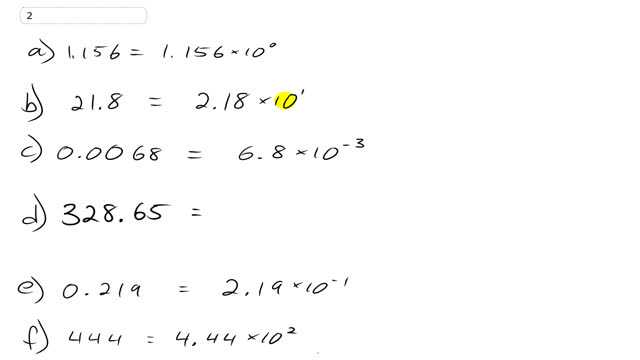
Write the following numbers in powers of 10 notation:
- 1.156,
- 21.8,
- 0.0068,
- 328.65,
- 0.219, and
- 444.
b)
c)
d)
e)
f)

In order to watch this solution you need to have a subscription.
This is Giancoli Answers with Mr. Dychko. For powers of 10 notation or also called scientific notation, you need to have a single digit to the left of the decimal and then you multiply by 10 to the power of whatever it takes to make the quantity that you actually want. So in the first case here, multiplying by 10 to the power of something is a bit silly because there's nothing to do; it already has one digit to the left of the decimal. But if we have to multiply by times 10 to the power something, we'll go 10 to the power of zero because that is the number 1 and so it doesn't change it at all. In part (b), we have 21.8 and the reason I know that it's 10 to the power of 1 is because well first I ask what should I do to this number in order to make only a single digit to the left of the decimal and I mean which power of 10 should I multiply or divide by and in this case, I'd have to divide by 10 to the power of 1 in order to make 21.8 into 2.18 and then you have to compensate for that by multiplying by the same thing times 10 to the power of 1 because in fact, you are multiplying by the number 1 although it doesn't look like it but it's 10 to the 1 over 10 to the 1 and it's always that way for all of these conversions— you are multiplying by 1 in the sense— because you are not actually allowed to change the quantity; you wanna have the same value, you just want it represented differently. So first step is to figure out what to do to make this given number have one digit to the left of the decimal and then in this case, you divide by 10 to the power of 1 and then what needs to be done to undo that change and so we multiply by 10 to the power of 1 and this is what we'll write here. So we have 2.18 times 10 to the 1 is the same quantity as what we started with 21.8. For 0.0068 to get this decimal place three places to the right, you multiply by 10 to the power of 3. Now we have to undo that though and then divide by 10 to the power of 3 as well but dividing by 10 to the power of 3 is the same as multiplying by 10 to the negative 3 so that kind of explains what this is about. So anytime you divide by 10 to the power of something, it's the same as multiplying by 10 to the negative of that; that negative exponent is also thought of as reciprocal or dividing by. And then same kinda thing going forward here, we have 328.65 divided by 10 to the power of 2 to move this decimal place to the left twice and then undo that change by multiplying by 10 to the power of 2 and our answer will be 3.2865 times 10 to the 2. And then for this one, you have to multiply by 10 to the power of 1 and then what do we have to undo that change divide by 10 to the 1 and whatever it is that you have to do to undo the initial change is what gets put over here and when you are dividing by 10 to the power of something, it's times 10 to the negative of that exponent. And 444 is decimal place goes twice to the left so that means divide by 10 to the 2 and to undo that change, you multiply by 10 to the 2 and this is what ends up going here; 4.44 times 10 to the 2 there.
Hello, I have the 7th edition textbook and my Part D is 27.635 instead of 328.66
Hello, thank you for reporting this Guccisosa. It sounds like you have a more recent printing of the 7th edition, and I hope there are not any other discrepancies between our versions.